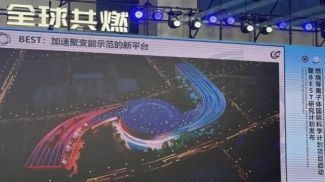
BEIJING, 25 September (BelTA - China Daily) - After six years of
construction, the Changtai Yangtze River Bridge, which has set several
world records, in Jiangsu province.
Spanning 10.03 kilometers, the bridge is the first crossing over the Yangtze River to integrate expressways, intercity railways and regular highways. It connects Changzhou and Taizhou, cutting travel time between the two cities from 1 hour and 20 minutes to about 20 minutes.
The bridge has set various world records. It is the longest-span cable-stayed bridge, the longest-span combined road-rail steel truss arch bridge and has the longest continuous length of steel truss girders. In addition, several world-first technologies were used during construction.
The bridge features a main span of 1,208 meters and two side spans of 388 meters. Its towers stand 350 meters tall - equivalent to a 120-story building.
"This is truly a world-class project," said Li Zhen, onsite commander of the construction command for the Jiangsu provincial transportation engineering construction bureau.
Li said the main span was designed to minimize impact on the Yangtze River's ecological environment and navigation routes.
For the first time, carbon fiber tendons - which are less affected by temperature changes - were used to create lightweight, high-strength, ultra-long composite material cables, marking a breakthrough in the application of new materials in bridge engineering.
The bridge supports a load capacity of 530,000 metric tons, with two main towers and stay cables providing structural support.
China Railway Baoji Bridge Group, the construction company, also developed several pioneering technologies.
The bridge passed its load test - considered its final exam - with 110 heavy trucks totaling 4,400 tons, demonstrating its structural integrity.
Jiangsu has now completed 20 river-crossing passages and has nine more under construction, effectively connecting counties and cities across the Yangtze.
Spanning 10.03 kilometers, the bridge is the first crossing over the Yangtze River to integrate expressways, intercity railways and regular highways. It connects Changzhou and Taizhou, cutting travel time between the two cities from 1 hour and 20 minutes to about 20 minutes.
The bridge has set various world records. It is the longest-span cable-stayed bridge, the longest-span combined road-rail steel truss arch bridge and has the longest continuous length of steel truss girders. In addition, several world-first technologies were used during construction.
The bridge features a main span of 1,208 meters and two side spans of 388 meters. Its towers stand 350 meters tall - equivalent to a 120-story building.
"This is truly a world-class project," said Li Zhen, onsite commander of the construction command for the Jiangsu provincial transportation engineering construction bureau.
Li said the main span was designed to minimize impact on the Yangtze River's ecological environment and navigation routes.
For the first time, carbon fiber tendons - which are less affected by temperature changes - were used to create lightweight, high-strength, ultra-long composite material cables, marking a breakthrough in the application of new materials in bridge engineering.
The bridge supports a load capacity of 530,000 metric tons, with two main towers and stay cables providing structural support.
China Railway Baoji Bridge Group, the construction company, also developed several pioneering technologies.
The bridge passed its load test - considered its final exam - with 110 heavy trucks totaling 4,400 tons, demonstrating its structural integrity.
Jiangsu has now completed 20 river-crossing passages and has nine more under construction, effectively connecting counties and cities across the Yangtze.













